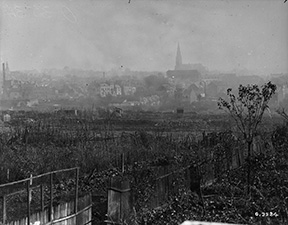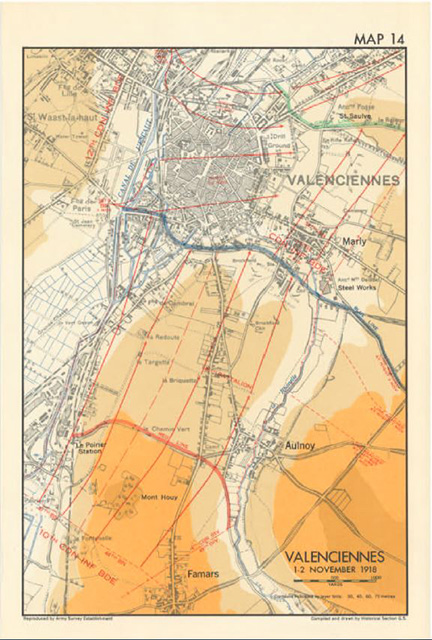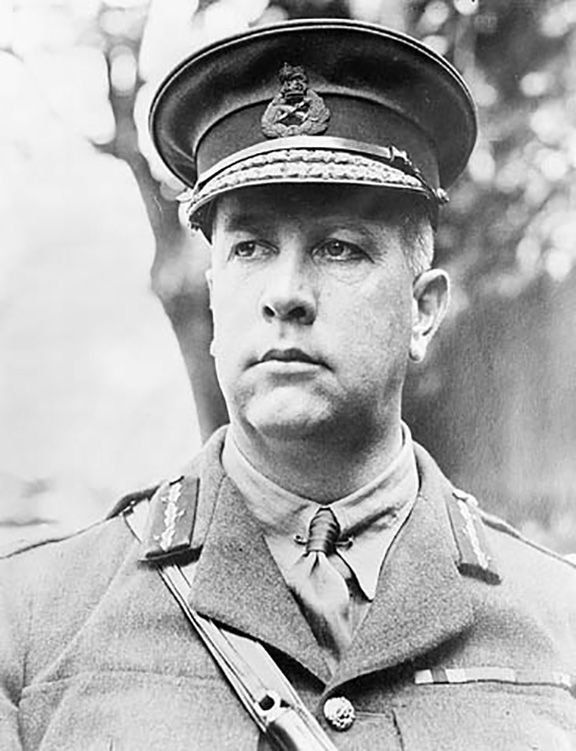Valenciennes
First World War

View of Valenciennes before the Canadians entered the town on 1st Nov., 1918. Fires started by enemy can be seen.
Credit: Canada. Dept. of National Defence / Library and Archives Canada / PA-003623; (MIKAN no. 3329396)
Date
1 – 2 November 1918
Geographical parameters
The Bavai-Cambrai road as far as Vendegies: thence the stream to Monchaux-sur-Ecaillon: thence a line to Haveluy (exclusive) – Bellaing (exclusive) – Aremberg (exclusive): thence along the southern edge of the forests of Vicoigne and Raismes
Context
A battle honour incorporating the tactical incident “Capture of Mont Houy”, formally entitled the “Battle of Valenciennes”, and itself being part of “The Final Advance”Footnote 1.

The first Canadian patrol entering Valenciennes from the West. November, 1918.
Credit: Canada. Dept. of National Defence/Library and Archives Canada; (MIKAN no. 3522309)
Description
During the latter part of October 1918 the German forces continued their withdrawal along the northern part of the Western Front closely followed by British troops which included the Canadian Corps (Lieutenant-General Sir A.W. Currie) of the First British Army among their number. Both sides were weary, but both also recognized that the last German defensive line, The Hermann Line, based on the city of Valenciennes, had been reached. Valenciennes' defenses were anchored on the Canal de l'Escaut which flowed along the city's western side. In looking at the operational situation it was evident that Mont Houy, a 60-metre high hill that lay just over a kilometre south of the city, held the key. The British attacked the well-defended Mont Houy but in their weakened state failed to take it. The Canadian Corps Commander, Sir Arthur Currie, then offered to do the job. Using a total of 303 guns of various calibres Canadian gunners buried Mont Houy in an avalanche of artillery fire. The infantry assault that followed discovered over 800 enemy dead on the position while a further 1,800 enemy soldiers surrendered to the four attacking Canadian battalions. The advance then continued to sweep forward into the city itself. That night mopping up parties patrolled the city. One of these parties became involved in a fire fight that saw four Canadians taking on approximately 60 Germans. The fight ended with a German surrender and the last award of the Victoria Cross to a Canadian in the Great War. Unfortunately, Sergeant Hugh Cairns' VC was to be a posthumous one.

Map depicts the advance into the city of Valenciennes by the C.E.F.
Credit: Map by Nicholson in CEF 1914-1919.

General Currie, Commander of the Canadian troops in France, and A.D.C. Location unknown. June, 1917.
Credit: Canada. Department of National Defence/Library and Archives Canada/PA-001370 (MIKAN no. 3191901)
Awarded to:
Currently Serving Units
- The British Columbia Regiment (Duke of Connaught's Own)
Awards to the 102nd Canadian Infantry Battalion, CEF (GO 110/29), The North British Columbia Regiment (GO 123/29), and The Irish Fusiliers of Canada (GO 71/30) - The Cameron Highlanders of Ottawa
Awards to the 38th Canadian Infantry Battalion, CEF (GO 123/29) and The Ottawa Highlanders (GO 110/29) - The Canadian Grenadier Guards
Awards to the 87th Canadian Infantry Battalion, CEF (GO 110/29) and The Canadian Grenadier Guards (GO 110/29) - The Cape Breton Highlanders
Awards to the 85th Canadian Infantry Battalion, CEF (GO 110/29) and The Cape Breton Highlanders (GO 110/29) - The Governor General's Horse Guards
Awards to the 4th Canadian Mounted Rifles Battalion, CEF (GO 110/29), The Governor General's Body Guard (GO 112/35), and The Mississauga Horse (GO 110/29) - The King's Own Calgary Regiment (RCAC)
Awards to the 50th Canadian Infantry Battalion, CEF (GO 110/29) and The Calgary Regiment (GO 110/29) - The Lake Superior Scottish Regiment
Awards to the 52nd Canadian Infantry Battalion, CEF (GO 123/29) and The Lake Superior Regiment (GO 110/29) - The North Saskatchewan Regiment
Awards to the 1st Canadian Mounted Rifles Battalion, CEF (GO 110/29) and The Saskatchewan Mounted Rifles (GO 110/29) - The Ontario Regiment (RCAC)
Awards to the 116th Canadian Infantry Battalion, CEF (GO 110/29) and The Ontario Regiment (GO 123/29) - The Rocky Mountain Rangers
Award to The Rocky Mountain Rangers (GO 71/30) - The Royal Canadian Hussars (Montreal)
Awards to the 1st Canadian Motor Machine Gun Brigade, CEF (GO 110/29) and the 1st Motor Machine Gun Brigade (GO 110/29) - The Royal New Brunswick Regiment
Award to The Carleton Light Infantry (GO 110/29) - The Royal Westminster Regiment
Awards to the 47th Canadian Infantry Battalion, CEF (GO 110/29) and The Westminster Regiment (GO 110/29) - The Royal Winnipeg Rifles
Award to the 44th Canadian Infantry Battalion, CEF (GO 110/29) - The Saskatchewan Dragoons
Awards to the 46th Canadian Infantry Battalion, CEF (GO 110/29) and The King's Own Rifles of Canada (GO 110/29) - The Seaforth Highlanders of Canada
Awards to the 72nd Canadian Infantry Battalion, CEF (GO 5/31) and The Seaforth Highlanders of Canada (GO 5/31) - The Sherbrooke Hussars
Awards to the 5th Canadian Mounted Rifles Battalion, CEF (GO 110/29) and the 7th/11th Hussars (GO 10/39) - The Toronto Scottish Regiment (Queen Elizabeth The Queen Mother's Own)
Awards to the 75th Canadian Infantry Battalion, CEF (GO 110/29) and The Toronto Scottish Regiment (GO 110/29)
Units on the Supplementary Order of Battle
- 24th Field Artillery Regiment, RCA
Awards to the 54th Canadian Infantry Battalion, CEF (GO 110/29) and The Kootenay Regiment (GO 110/29) - 27th Field Artillery Regiment, RCA
Award to The Eastern Townships Mounted Rifles (GO 110/29) - 50th Field Artillery Regiment (The Prince of Wales' Rangers), RCA
Awards to the 4th Battalion, Canadian Machine Gun Corps, CEF (GO 123/29) and the 4th Machine Gun Battalion, CMGC (GO 123/29) - 118th Medium Battery, RCA
Awards to the 1st Canadian Mounted Rifles Battalion, CEF (GO 110/29) and The Manitoba Mounted Rifles (GO 5/31) - The Winnipeg Grenadiers
Awards to the 78th Canadian Infantry Battalion, CEF (GO 110/29) and The Winnipeg Grenadiers (GO 110/29)
Page details
- Date modified: